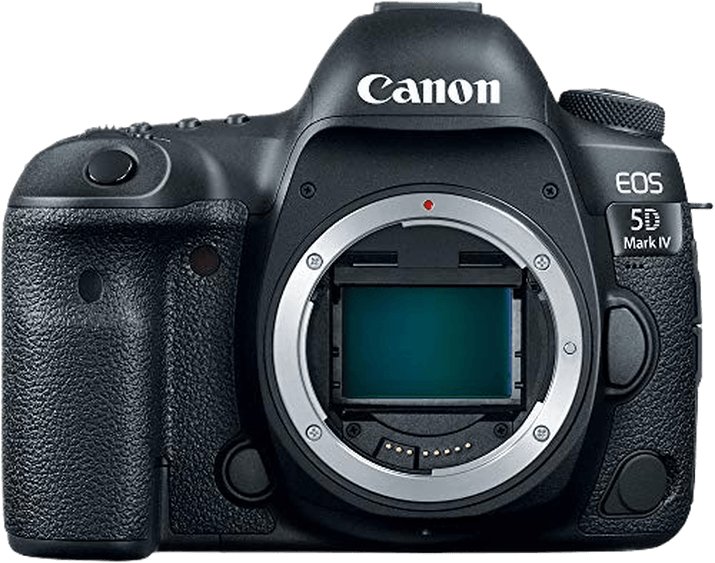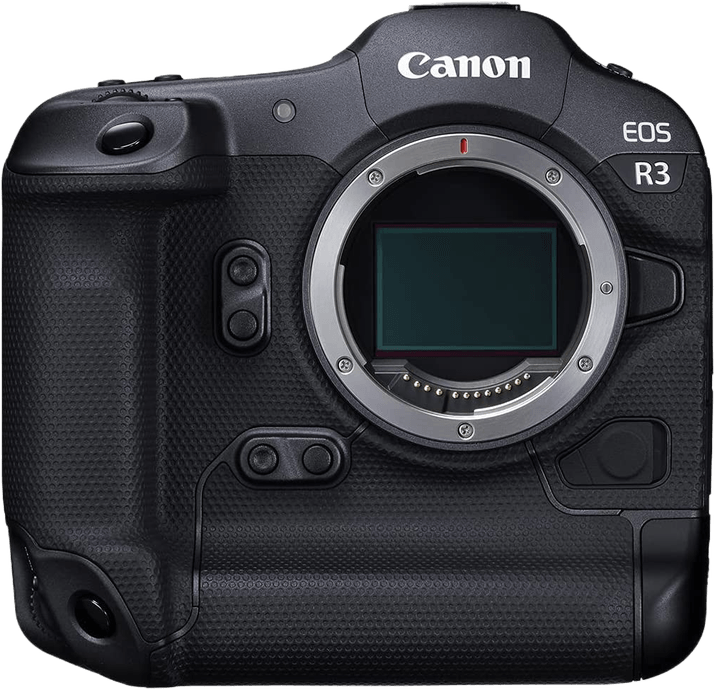Canon EOS 5D Mark IV vs EOS R3 Comparison
Canon EOS 5D Mark IV

Canon EOS R3

The Canon EOS R3 outshines the Canon EOS 5D Mark IV with a score of 84/100, compared to the latter’s 75/100. Both cameras share common features such as being part of the Canon EOS series and having similar camera sizes. However, the EOS R3 is a mirrorless camera, while the 5D Mark IV is a DSLR.
The EOS R3’s higher score is due to its more advanced technology and better performance. As a mirrorless camera, it offers a lighter and more compact design compared to the EOS 5D Mark IV. However, the EOS 5D Mark IV still has some advantages, such as a lower launch price of $3500 compared to the EOS R3’s $5999.
When comparing these two cameras, the Canon EOS R3 is the clear winner in terms of performance and innovation, while the EOS 5D Mark IV provides a more budget-friendly option for those who don’t need the latest features.
Canon EOS 5D Mark IV vs EOS R3 Overview and Optics
The Canon EOS R3 wins in the optics comparison with a score of 84/100, while the Canon EOS 5D Mark IV scores 76/100. Both cameras share several specifications, such as sensor type (CMOS), sensor size (Full Frame), and processors from the same family (Digic 6+ for the 5D Mark IV and Digic X for the R3). However, there are notable differences that contribute to the R3’s higher score.
The EOS R3 excels due to its faster shooting speed of 30 frames per second compared to the 5D Mark IV’s 7 frames per second. It also has a higher DXOMARK score for its sensor (96 versus 91), reflecting better overall image quality. The R3’s lens mount (Canon RF) offers more compatibility with newer lenses, and its image stabilization feature provides an advantage for capturing sharper images in various shooting conditions.
On the other hand, the EOS 5D Mark IV has a higher megapixel count of 30.4, which may result in more detailed images. However, this advantage is somewhat offset by its slower shooting speed and lower sensor score. Its lens mount (Canon EF) is compatible with a wide range of existing lenses, but may not offer the same future-proofing as the R3’s RF mount.
Considering these factors, the Canon EOS R3 is the better choice for photographers seeking faster shooting speeds, better image quality, and compatibility with newer lenses. The image stabilization feature further enhances its capabilities. Although the Canon EOS 5D Mark IV offers a higher megapixel count, it falls short in other areas, making it a less appealing option when compared to the R3.
Canon EOS 5D Mark IV vs EOS R3 Video Performance
The Canon EOS R3 outperforms the Canon EOS 5D Mark IV in video capabilities, scoring 96/100 compared to the latter’s 91/100. Both cameras share some common specifications, such as a maximum video frame rate of 120fps and built-in time-lapse functionality. However, the EOS R3 surpasses the 5D Mark IV in terms of video resolution and dimensions, making it the superior choice for video recording.
The winning EOS R3 boasts a 6K maximum video resolution, which is significantly higher than the 5D Mark IV’s 4K resolution. Additionally, the R3’s maximum video dimensions are 6000 x 3164, whereas the 5D Mark IV offers dimensions of 4096 x 2160. The higher resolution and larger dimensions provided by the EOS R3 result in sharper, more detailed video footage, which is an undeniable advantage for videographers.
On the other hand, the Canon EOS 5D Mark IV has its merits as well. Although it has a lower video resolution and smaller dimensions than the EOS R3, it still delivers high-quality 4K video, which is suitable for most professional and personal video projects. In fact, the 5D Mark IV’s video capabilities remain impressive and functional for a wide range of applications.
In comparing the video capabilities of the Canon EOS 5D Mark IV and the Canon EOS R3, it is clear that the R3 is the superior choice for those seeking higher resolution and larger dimensions. However, the 5D Mark IV remains a strong contender, offering reliable and high-quality video performance that will satisfy the needs of many users. Ultimately, the choice between these two cameras will depend on individual preferences and requirements in terms of video quality and resolution.
Canon EOS 5D Mark IV vs EOS R3 Features and Benefits
The Canon EOS R3 outperforms the Canon EOS 5D Mark IV with a feature score of 87/100 compared to the 5D Mark IV’s 74/100. Both cameras share several specifications, such as a 3.2-inch touchscreen, GPS, and WIFI capabilities. However, the EOS R3 surpasses the 5D Mark IV in certain aspects, while the 5D Mark IV has a few advantages of its own.
The EOS R3’s screen resolution of 4,150,000 dots is significantly higher than the 5D Mark IV’s 1,620,000 dots, providing a much clearer and more detailed display. Additionally, the R3 has a flip screen, offering greater flexibility when composing shots from different angles. The R3 also includes Bluetooth connectivity, allowing for seamless integration with compatible devices.
On the other hand, the EOS 5D Mark IV does not have a flip screen and lacks Bluetooth connectivity. Despite these drawbacks, the 5D Mark IV remains a reliable and capable camera, particularly for those who do not require the additional features offered by the R3.
In comparing the Canon EOS R3 and EOS 5D Mark IV, the R3 emerges as the superior camera due to its higher feature score, enhanced screen resolution, flip screen, and Bluetooth capabilities. However, the 5D Mark IV still provides a solid option for photographers who may not need the extra features of the R3. Ultimately, the choice between these two cameras will depend on individual preferences and requirements.
Canon EOS 5D Mark IV vs EOS R3 Storage and Battery
The Canon EOS R3 triumphs over the Canon EOS 5D Mark IV in storage and battery with a score of 81/100 compared to 71/100. Both cameras share two memory card slots and accept SD/SDHC/SDXC cards. However, the EOS R3 has a clear advantage with its compatibility for CFexpress Type B cards, which are UHS-II compatible, allowing for faster data transfer rates.
Regarding battery life, the Canon EOS 5D Mark IV has an edge with 900 shots per charge, whereas the EOS R3 provides 760 shots. Despite this, the EOS R3 has the added benefit of USB charging and uses the LP-E19 battery type, while the 5D Mark IV relies on the LP-E6N battery and lacks USB charging capabilities.
To sum up, the Canon EOS R3 takes the lead in storage and battery due to its compatibility with faster memory cards and USB charging functionality. The Canon EOS 5D Mark IV holds a slight advantage in battery life, but it does not outweigh the benefits of the EOS R3.
Canon EOS 5D Mark IV vs EOS R3 – Our Verdict
Are you still undecided about which camera is right for you? Have a look at these popular comparisons that feature the Canon EOS 5D Mark IV or the Canon EOS R3:

